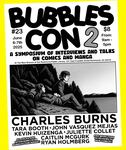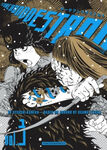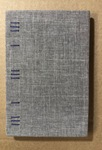
For some years now, Dutchman Erik Kriek has been producing an excellent series of pantomime (i.e. -- "silent"; no words; like those of fellow European, Jason) comics. Way hep Dutch publisher Oog & Blik is the responsible party for this fine collection of the first five issues of Gutsman Comics. What's Gutsman all about? Well, it's kind of hard to explain, but it's pretty much about the interior life of it's creator, a middle-aged, urban, bourgeois male living in Amsterdam, in which his family life, love life and fantasy life all get jumbled together. It's fun, well done and worth a look.
Long out of print, but we still lhave ONE new copy!

In the Pines by Erik Kriek adapts five "murder ballads": one traditional – "Pretty Polly (And The Ship’s Carpenter)", which has its murky origins somewhere in the early 18th century – and four composed in the latter half of the 20th century: "The Long Black Veil" by Danny Dill & Marijohn Wilkin; "Taneytown" by Steve Earle; Gillian Welch's haunting "Caleb Meyer"; and concluding with "Where the WIld Roses Grow" by Nick Cave. Printed in duotone throughout, with a different tone for each piece. Lyric darkness delineated.

From the author of the verse novella, The Wild Party, which was graphically adapted by Art Spiegelman (and which, evidently, we failed to ever list here on the site!) and the artist behind In the Pines comes this graphic adaptation of March's later, lesser known work. The Set-Up – also a verse novella, in six parts – tells the story of a black boxer fighting on multiple fronts, emerging victorious on the spiritual plane even as he is crushed by the exploitative society in which his tale unfolds.
Written by March in 1928 and set in the nether reaches of what readers can only assume is New York City, it may have seemed progressive and sympathetic in its portrayal of the boxer – ironically named Pansy – at the time, but not so much now nearly 100 years later, as its sympathies are grounded in preconceived notions regarding race that are clearly retograde and to varying degrees offensive today; although, that said, no one comes off well here, as the entire work is framed from a class perspective that sees itself as looking down from above the fray. March's writing is crisp and propulsive and Kriek's black & white & gray illustration is dark and brooding, making for an intriguing and bracing contrapuntality that is the saving attribute of this adaptation of a work that might otherwise best be forgotten.
We found a few brand new copies of this difficult-to-find (and possibly out of print) – in the US – of this attractively designed and attentively printed hardcover book from London-based publisher, Korero Press, in The Archives.

It's been a minute, but Erik Kriek is back with a new – and haunting – graphic novel. The Pit is a full-size, 144 page hardcover, printed in a duotone palette made up of an array of pastel green and orange tones on flat white paperstock. Amsterdam-based Kriek is renowned for his moody, woodcut style comics, and he's in top form here in The Pit, a tale of coming to terms with personal loss set in the rural countryside of the Netherlands that takes some unexpeted twists and turns, leading into a psychological territory where things may not be what they seem...
We've provided a taste of what's in store up at the Copacetic Tumblr, HERE.
INTRO SPECIAL PRICE










